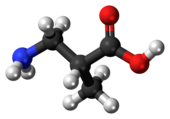3-アミノイソ酪酸
| 3-アミノイソ酪酸 | |
|---|---|
 | |
 | |
3-Amino-2-methylpropanoic acid | |
別称 3-Aminoisobutyrate | |
| 識別情報 | |
| CAS登録番号 | 144-90-1  |
| PubChem | 64956 |
| ChemSpider | 58481  |
| KEGG | C05145  |
| ChEBI |
|
| |
| |
| 特性 | |
| 化学式 | C4H9NO2 |
| モル質量 | 103.12 g/mol |
| 特記なき場合、データは常温 (25 °C)・常圧 (100 kPa) におけるものである。 | |
3-アミノイソ酪酸(3-Aminoisobutyric acidまたはβ-aminoisobutyric acid, BAIBA)は、チミンの異化によって形成される化合物である。
運動中のPGC-1αタンパク質の増加が、運動している筋肉から血液へのBAIBAの分泌の引き金となる(ヒト血清中濃度は2–3 μM)。BAIBAが白色脂肪組織に達すると、PPARα受容体を通して熱発生遺伝子の発現を活性化させ、白色脂肪組織を褐色化させる[1]。BAIBAの活性によってもたらされる結果の1つは、BAIBAの標的細胞の基礎代謝の増加である。
近年になって、脂肪の燃焼、インスリンやトリグリセリド、総コレステロールの調節等、細胞代謝に役割を持っていることが推測されている[2]。
出典
- ^ Roberts, Lee D.; Bostrom, Pontus; o'Sullivan, John F.; Schinzel, Robert T.; Lewis, Gregory D.; Dejam, Andre; Lee, Youn-Kyoung; Palma, Melinda J. et al. (2014). “Β-Aminoisobutyric Acid Induces Browning of White Fat and Hepatic β-Oxidation and is Inversely Correlated with Cardiometabolic Risk Factors”. Cell Metabolism 19 (1): 96-108. doi:10.1016/j.cmet.2013.12.003. PMC 4017355. PMID 24411942. https://www.ncbi.nlm.nih.gov/pmc/articles/PMC4017355/.
- ^ “Researchers discover molecule behind the benefits of exercise”. Medical Express. 2019年8月30日閲覧。





